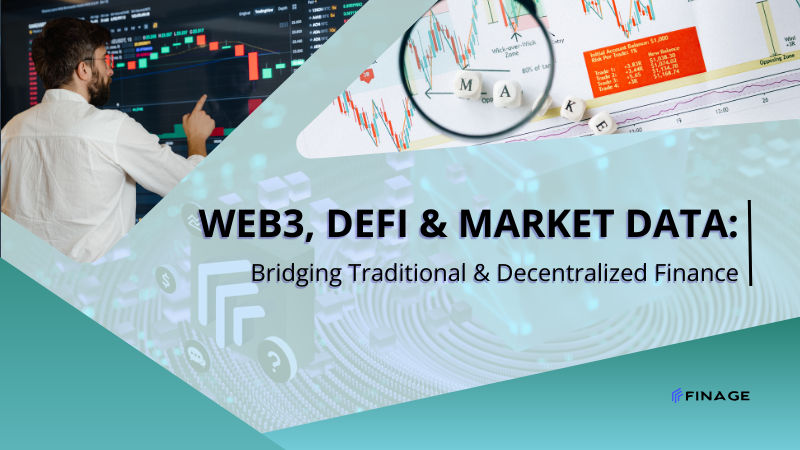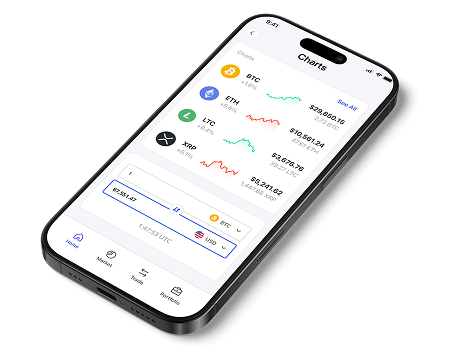How Market Data APIs Bridge Traditional Finance and DeFi
7 min read • May 17, 2025

Introduction
As the financial world evolves, Web3 and DeFi are no longer experimental spaces—they’re reshaping how markets operate, how users interact with assets, and how platforms access and distribute data. But while decentralized systems promise transparency and autonomy, they still rely on something very traditional: market data.
From DEXs and liquidity protocols to on-chain oracles and DeFi dashboards, reliable real-time and historical market data is critical to building trust and functionality. That’s where unified APIs like Finage come in—bridging the gap between centralized data infrastructure and decentralized finance.
In this post, we’ll explore how market data APIs enable DeFi platforms to operate smoothly, how Web3 builders can access institutional-grade data, and why merging TradFi and DeFi systems with scalable APIs is the next step in building robust, trustless infrastructure.
Table of Contents
- Why DeFi Still Depends on Traditional Market Data
- How Web3 Protocols Use Market Feeds (Beyond Price)
- The Role of Unified APIs in Cross-System Finance
- How Finage Connects DeFi Builders to Real-Time Market Data
- Web3 + TradFi Use Case: Oracles, Aggregators, DEX Dashboards
- Final Thoughts: Powering the Future of Finance with Connected Data
1. Why DeFi Still Depends on Traditional Market Data
Decentralized finance promises open, borderless financial systems. But for DeFi platforms to operate with price accuracy, transparency, and reliability, they still need one thing from the traditional world: trusted market data.
Whether it's a decentralized exchange (DEX), lending protocol, yield aggregator, or derivatives platform, every smart contract interaction depends on real-time and historical off-chain price data to calculate:
- Collateral ratios
- Lending limits
- Liquidation triggers
- Index-based rewards
- Token valuations
And while on-chain metrics like TVL or gas fees are native to Web3, most assets traded in DeFi—like stablecoins or synthetic stocks—mirror off-chain assets. That means accurate tracking of:
- Stock prices (e.g., TSLA, AAPL)
- Forex pairs (e.g., EUR/USD)
- Crypto across CEXs and DEXs
- Commodities and indices (e.g., gold, US500)
Without access to real-world market data through reliable APIs or oracles, DeFi protocols can misprice risk, over-leverage positions, or open themselves up to exploits.
2. How Web3 Protocols Use Market Feeds (Beyond Price)
When people think of DeFi and market data, they often picture real-time price oracles. But Web3 protocols use market feeds for much more than just showing a token’s value. In reality, price is just one layer—the full picture includes time-series trends, volatility, fundamentals, and market sentiment.
Here’s how decentralized apps (dApps) and protocols integrate market data in more complex ways:
Lending & Collateral Management
Lending platforms like Aave or Compound depend on live and historical price feeds to calculate LTV ratios, health factors, and liquidation thresholds. A sudden dip in ETH price? That’s a liquidation event—unless it's caught with a trusted feed.
Synthetic Asset Tracking
Platforms that offer tokenized versions of traditional stocks or indices (e.g., synthetic TSLA, S&P 500, or gold) require real-time stock and index data to ensure the synthetic price mirrors the real-world asset.
Yield Aggregation & Risk Modeling
Yield optimizers use historical volatility and trend data to assess risk in different liquidity pools. Time-based data helps measure performance stability, estimate returns, and manage rebalancing strategies.
Automated Alerts, Triggers, and Bots
Whether it’s an auto-redeem on a stablecoin vault or a strategy trigger on a DEX, many smart contracts and bots rely on threshold-based market data to automate decisions without human input.
Oracle Protocols & Cross-Chain Bridges
Even oracle networks (like Chainlink, Supra, or API3) depend on accurate market feeds from off-chain APIs to serve on-chain consumers. The cleaner and more consistent the data, the more trustworthy the oracle result.
3. The Role of Unified APIs in Cross-System Finance
As DeFi expands and traditional finance becomes more programmable, developers are no longer building on isolated stacks—they’re building across ecosystems. That’s where unified market data APIs become essential.
A unified API provides real-time and historical data across all major asset classes—stocks, crypto, forex, indices, and ETFs—through a single, standardized interface. This is crucial for teams operating in both Web2 and Web3 environments.
Here’s how unified APIs simplify the future of finance:
Bridging On-Chain and Off-Chain Systems
Instead of manually connecting to CEXs, stock exchanges, and crypto feeds separately, a unified API delivers everything via one consistent format, making it easier to bridge off-chain pricing into on-chain logic.
Less Infrastructure, More Functionality
Startups and DeFi teams don’t want to maintain five APIs for different asset classes. With a unified API, you can pull global stock data, stream crypto prices, and track FX in one integration—ideal for multichain dashboards or oracle infrastructure.
Consistent JSON = Cleaner Smart Contract Interfaces
Unified APIs return structured, predictable JSON, perfect for formatting and signing off-chain data for oracle or smart contract consumption without needing transformation layers.
Better Accuracy, Lower Risk
When your data source is fragmented, you risk delay, inconsistency, and manipulation. A unified API reduces reliance on multiple feeds and helps maintain price consistency across chains and protocols.
Platforms like Finage enable this by offering multi-asset, high-performance market data APIs—bridging traditional finance and Web3 without compromising speed or accuracy.
4. How Finage Connects DeFi Builders to Real-Time Market Data
Finage is designed to help DeFi developers, oracle networks, and Web3 platforms access trusted market data from traditional sources, without the complexity of legacy systems or fragmented feeds.
Here's how Finage makes real-time market data integration easy for decentralized products:
One API Key, All Markets
Access stocks, ETFs, indices, crypto, and forex in one platform. DeFi apps can support multiple asset classes with a single integration—ideal for synthetic assets, tokenized securities, and cross-market dashboards.
WebSocket for Real-Time Feeds
Stream live price updates for any symbol across all supported markets. Web3 developers can feed this into bots, triggers, or off-chain data layers with ultra-low latency.
Example WebSocket subscription:
{
"symbol": "AAPL",
"ask": 121.34,
"bid": 121.32,
"timestamp": 1614869528663
}
Historical OHLCV Data
Use Finage's REST API to pull minute-level or daily price history for stocks, forex, and crypto—perfect for generating chart data, time-based metrics, or volatility modeling.
JSON Structure Built for Smart Contracts
Finage returns clean, standardized JSON payloads across all endpoints—ideal for wrapping into Oracle submissions, signing, or piping into indexing layers like The Graph or API3 Airnode.
Global Market Coverage
Finage sources and aggregates data from multiple institutional-grade providers, giving DeFi teams access to trusted, production-grade data, without dealing with exchange-level limitations.
Whether you're feeding Chainlink oracles, powering a DEX UI, or building a synthetic trading protocol, Finage gives you accurate, scalable market data built for both sides of the financial future.
5. Web3 + TradFi Use Case: Oracles, Aggregators, DEX Dashboards
DeFi apps aren’t standalone projects—they’re often part of a broader data flow that moves between off-chain APIs, oracles, smart contracts, and frontend dashboards. Let’s look at where a market data API like Finage fits into that flow.
Oracles: Feeding Smart Contracts with Off-Chain Prices
Oracle networks (e.g., Chainlink, Supra, API3) rely on off-chain APIs to provide real-world data to on-chain apps. Finage can be used as a trusted data source to:
- Stream or fetch asset prices (stocks, forex, crypto)
- Format that data as JSON
- Push it to the blockchain via oracle protocols
Use Case: Feeding real-time stock prices into a synthetic asset minting protocol.
Yield Aggregators & Vault Optimizers
These protocols use historical and real-time data to calculate risk, volatility, and yield potential across DeFi platforms. With Finage, they can pull:
- Intraday OHLCV data for assets in vaults
- Market momentum or correlation across sectors
- Real-time pricing for rebalancing decisions
Use Case: A yield optimizer deciding when to rotate capital based on macro market movements.
DEX Dashboards & Analytics Tools
Decentralized exchanges and analytics apps use clean market data to show:
- Price charts for tokenized real-world assets
- Live order book overlays using bid/ask feeds
- Time-based performance metrics for on-chain tokens vs. real-world indexes
Use Case: A Uniswap-like frontend showing live SPY token price next to the real S&P 500 price pulled via Finage.
All of these rely on accurate, unified, low-latency market data—exactly what Finage delivers with its multi-asset REST and WebSocket APIs.
6. Final Thoughts: Powering the Future of Finance with Connected Data
Web3 is changing how we build financial systems—but it’s not replacing market data. It’s demanding better, faster, and more composable access to it.
As DeFi evolves, developers need tools that connect the speed and openness of decentralized protocols with the structure and accuracy of traditional markets. That’s where a unified market data API like Finage becomes essential.
With Finage, you get:
- Real-time and historical data for stocks, crypto, forex, indices, and ETFs
- One API for both REST and WebSocket access
- Structured JSON ready for oracles, dashboards, or smart contracts
- A scalable solution for both early-stage Web3 projects and institutional-grade platforms
Whether you're powering a DEX, streaming prices into a DeFi oracle, or building a hybrid fintech product that blends TradFi and Web3, Finage gives you the market data infrastructure to build with confidence.
You can get your Real-Time and Historical DEX Data with a free DEX Data API key.
Build with us today!
Claim Your Free API Key Today
Access stock, forex and crypto market data with a free API key—no credit card required.

Stay Informed, Stay Ahead
Finage Blog: Data-Driven Insights & Ideas
Discover company news, announcements, updates, guides and more
.png)
.png)
.png)